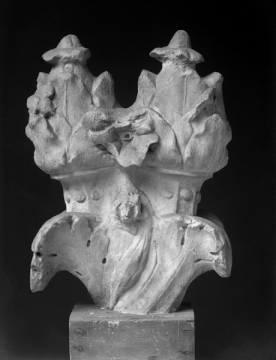Explore Collections


You are here:
CollectionsOnline
/
FOLIATED TERMINAL OF A SPIRAL SHAFT
Browse
FOLIATED TERMINAL OF A SPIRAL SHAFT
Luna marble
Height: 31cm
Width: 22cm
Thickness: 12cm
Width: 22cm
Thickness: 12cm
Museum number: S81
On display: Study
All spaces are in No. 13 Lincoln's Inn Fields unless identified as in No. 12, Soane's first house.
For tours https://www.soane.org/your-visit
Curatorial note
From the top of spiralled acanthus foliage rise double acanthus-bud tops with two orders of paired flowers carved on the sides between. The tips are unbroken and their delicate points preclude use of this shaft top as a support of any conceivable sort.
In 'The Shrine of St Peter and its Twelve Spiral Columns', J.B. Ward Perkins discusses these twisted and foliate shafts with double pinecone or acanthus finials as the Roman decorative forerunners of this specific manifestation of Eastern enrichment which left is impact on the early Medieval and Renaissance worlds in the form of the three sets of large spiral columns connected with the histories of old and new St. Peter's1. The evidence of the Soane fragments is introduced2 and Ward Perkins notes that there appears to be no surviving example of any of these shafts, outside St. Peter's, 'that is of monumental size or was certainly used in a strictly architectural setting.' The numerous Soane finials, shafts, and fragments support this observation, although we know Soane avoided buying objects of any but the smaller sizes because of space limitations in his museum and that Tatham collected only fragments which could be readily shipped to Henry Holland from Rome in troubled times and at no exceptional cost.
1 Journal of Roman Studies XLII, 1952, p. 21ff., esp. p.27f.
2 Loc. cit., p. 27, no. 32.
In 'The Shrine of St Peter and its Twelve Spiral Columns', J.B. Ward Perkins discusses these twisted and foliate shafts with double pinecone or acanthus finials as the Roman decorative forerunners of this specific manifestation of Eastern enrichment which left is impact on the early Medieval and Renaissance worlds in the form of the three sets of large spiral columns connected with the histories of old and new St. Peter's1. The evidence of the Soane fragments is introduced2 and Ward Perkins notes that there appears to be no surviving example of any of these shafts, outside St. Peter's, 'that is of monumental size or was certainly used in a strictly architectural setting.' The numerous Soane finials, shafts, and fragments support this observation, although we know Soane avoided buying objects of any but the smaller sizes because of space limitations in his museum and that Tatham collected only fragments which could be readily shipped to Henry Holland from Rome in troubled times and at no exceptional cost.
1 Journal of Roman Studies XLII, 1952, p. 21ff., esp. p.27f.
2 Loc. cit., p. 27, no. 32.
Rome; collected in Rome by Charles Heathcote Tatham for the architect Henry Holland during the 1790s. See Cornelius Vermeule, unpublished catalogue of the Antiquities at Sir John Soane's Museum, Introduction, transcription of Tatham letters, List 2, no.7.
Literature
Tatham: Etchings, 4; Drawings, 2.
J. B. Ward Perkins, Journal of Roman Studies, XLII, 1952, p. 27, no. 32.
J. B. Ward Perkins, Journal of Roman Studies, XLII, 1952, p. 27, no. 32.
Soane collections online is being continually updated. If you wish to find out more or if you have any further information about this object please contact us: worksofart@soane.org.uk


